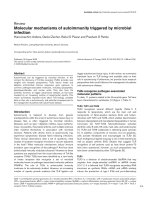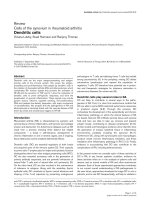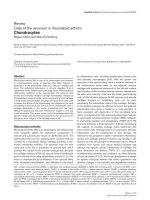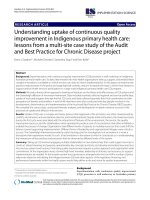Báo cáo y học: "Understanding genetics of sepsis: will new technology help" pot
Bạn đang xem bản rút gọn của tài liệu. Xem và tải ngay bản đầy đủ của tài liệu tại đây (39.82 KB, 2 trang )
Available online />Page 1 of 2
(page number not for citation purposes)
Abstract
High-throughput techniques, such as genome-wide scans,
will allow genotyping of a large number of single-nucleotide
polymorphisms throughout the human genome. There is
intense interest to apply this technology to understand genetics
of complex traits, including severe sepsis. To effectively utilize
this technology, large cohorts of septic patients will have to
be recruited. Careful attention should be paid to different
aspects of study design and analyses as large, multicenter
cohorts are assembled for genome-wide association studies.
Resistance to infection and its outcomes are influenced by a
complex interplay between the host, the microbe, and the
environment. Severe sepsis occurs due to abnormalities in
the host response to infection. There is great interest to
understand whether genetic determinants of the host
response to infection are associated with poor outcomes of
infection. Identifying these genetic determinants could be
important to improve performance of current risk prediction
models. Furthermore, the pharmacogenomics of sepsis will
allow us to target immune-modulating therapies. Despite
these plausible benefits and more than a decade of research,
the role of genetic determinants in severe sepsis remains
unclear. Results of some studies have been encouraging, but
these results have not been replicated consistently in
subsequent, larger studies.
In the previous issue of Critical Care, Sutherland and Walley
provide a broad overview of gene-association studies, the
most common study design to assess genetics of infection
and sepsis [1]. The review highlights genome-wide asso-
ciation studies (GWAS), an important and emerging
technology to understand genetics of complex traits. High-
density SNP platforms by Affymetrix (Santa Clara, CA, USA)
and Illumina (San Diego, CA, USA) allow genotyping of up to
one million SNPs. Imputation methods using linkage patterns
between SNPs genotyped using these platforms and data
from the International Hapmap project or prior results of
sequencing allow us to estimate additional unmeasured
genotypes [2]. This method increases the power and allows
comparison of results across different platforms. Up to two
million SNPs can therefore be analyzed using GWAS, which
may allow discovery of proteins that have not been studied in
the sepsis pathophysiology.
Similar to any new technology, the advantage of genotyping a
large number of polymorphisms poses unique challenges
during statistical analysis. For instance, given the sheer
number of variables that are tested, the traditional P value
cutoff points are clearly inadequate – and even P <10
–6
may
include a large number of false positives [3]. Furthermore,
since the relative risk of individual polymorphisms is likely to
be small, analyzing large samples will be necessary for
GWAS. Several thousand subjects should therefore be
included in these studies. A glance at Table 1 in Sutherland
and Walley’s article shows that current studies assessing
genetics of sepsis have been much smaller [1]. Finally,
replication is critical to confirm these results – often in several
cohorts, requiring collaborations across several research
groups.
The authors have also highlighted several issues with regards
to study design and analyses that are common to gene-
association studies, including candidate gene analysis and
GWAS, and that perhaps could pose more problems as
larger samples are collected for GWAS.
First, accurately defining the phenotype is critical for any
gene-association study. If infection and severe sepsis
susceptibility and outcomes are due to gene–environment
interaction, then determining the causal organism would be
important. Limitations of current microbiologic techniques,
however, allow an accurate determination of the causative
Commentary
Understanding genetics of sepsis: will new technology help?
Sachin Yende
1,2
and John A Kellum
1,2
1
The Clinical Research, Investigation, and Systems Modeling of Acute Illness (CRISMA) Laboratory, University of Pittsburgh, Pittsburgh, PA 15261, USA
2
Department of Critical Care Medicine, 604 Scaife Hall, University of Pittsburgh School of Medicine, 3550 Terrace Street, Pittsburgh, PA 15261, USA
Corresponding author: John A Kellum,
Published: 6 May 2009 Critical Care 2009, 13:141 (doi:10.1186/cc7727)
This article is online at />© 2009 BioMed Central Ltd
See related review by Sutherland and Walley, />GWAS = genome-wide association studies; SNP = single nucleotide polymorphism.
Critical Care Vol 13 No 3 Yende and Kellum
Page 2 of 2
(page number not for citation purposes)
agent in only a small number of cases. For instance, consider
a case–control design of Gram-positive organisms causing
community-acquired pneumonia with population-based
controls used to assess pneumonia susceptibility. In such a
study, we might exclude a large number of cases that are
culture-negative and include only those with severe
pneumonia who are culture-positive. An alternative approach
would be to include cases that are identified based on clinical
syndromes, such as severe sepsis, to identify genetic
variation within proteins that are likely to play an important
role in the broader host response to infection, regardless of
the causative agent.
Second, choosing appropriate controls is important as we
assess the role of genetic variants in the spectrum of infec-
tion and severe sepsis susceptibility. For example, comparing
the distribution of the genetic variant in severe sepsis cases
and healthy, population-based control individuals may be
confounded by the effect of the genetic variant on infection
susceptibility.
Third, the population admixture could often lead to false
positive results due to association between subgroups of the
population and the phenotype [4].
Finally, an important limitation of any association study is that
it cannot establish a cause–effect relationship.
Functional studies can be conducted to understand how
genetic variants alter the host response to infection and pose
special challenges. These studies are usually conducted
either in vitro using cell culture or in vivo using transgenic
rodents, either with knockouts to assess the effect of
removing the gene or with knockins to assess the affect of
adding the gene. While both of these methods can provide
useful information to help assess the functional effects of a
polymorphism in humans, there are significant limitations to
translating this work from the bench to the bedside.
In conclusion, new technology such as GWAS has the
potential to improve our understanding of genetics of sepsis.
Large studies will have to be conducted, however, to
effectively utilize this technology. Issues that are common to
gene-association studies should not be ignored, especially
since larger, multicenter, and collaborative efforts will be
required to design GWAS studies to understand the genetic
determinants of sepsis.
Competing interests
The authors declare that they have no competing interests
References
1. Sutherland AM, Walley KR: Bench-to-bedside review: Associa-
tion of genetic variation with sepsis. Crit Care 2009, 13:210.
2. Zeggini E, Scott LJ, Saxena R, Voight BF, Marchini JL, Hu T, de
Bakker PI, Abecasis GR, Almgren P, Andersen G, Ardlie K,
Bostrom KB, Bergman RN, Bonnycastle LL, Borch-Johnsen K,
Burtt NP, Chen H, Chines PS, Daly MJ, Deodhar P, Ding CJ,
Doney ASF, Duren WL, Elliott KS, Erdos MR, Frayling TM, Freathy
RM, Gianniny L, Grallert H, Grarup N, et al.: Meta-analysis of
genome-wide association data and large-scale replication
identifies additional susceptibility loci for type 2 diabetes. Nat
Genet 2008, 40:638-645.
3. The Wellcome Trust Case Control Consortium: Genome-wide
association study of 14,000 cases of seven common diseases
and 3,000 shared controls. Nature 2007, 447:661-678.
4. Cardon LR, Palmer LJ: Population stratification and spurious
allelic association. The Lancet 2003, 361:598-604.









